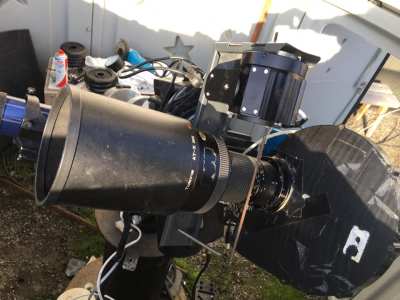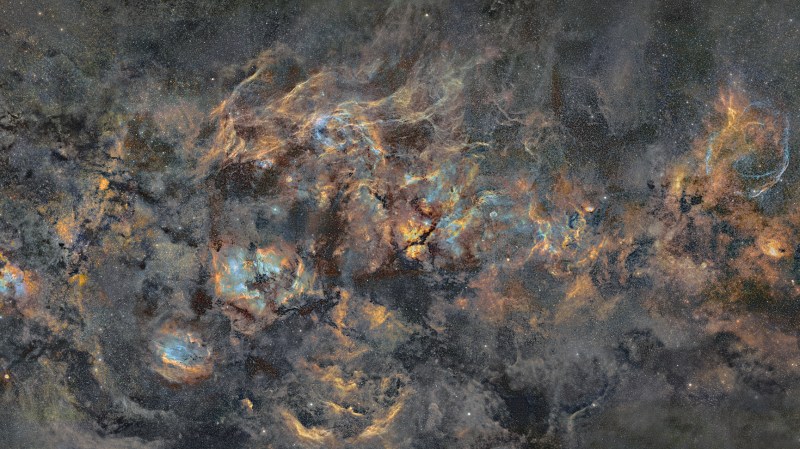Starting projects is easy. It’s the finishing part that many of us have trouble with. We can hardly imagine completing a project after more than a decade, but seeing the breathtaking results of [J-P Metsavainio]’s gigapixel composite image of our galaxy might just make us reconsider. The photograph, which we highly suggest you go check out in its full glory, has been in progress since 2009, features 1250 total hours of exposure time, and spans across 125 degrees of sky. It is simply spectacular.
Of course, it wasn’t an absolutely continuous effort to make this one image over those twelve years. Part of the reason for the extended time span is many frames of the mosaic were shot, processed, and released as their own individual pieces; each of the many astronomical features impressive in its own right. But, over the years, he’s filled in the gaps between and has been able to release a more and more complete picture of our galactic home.
 A project this long, somewhat predictably, eventually outlives the technology used to create it. Up until 2014, [Metsavainio]’s setup included a Meade 12-inch telescope and some modified Canon optics. Since then, he’s used a dedicated equatorial mount, astrocamera, and a Tokina lens (again, modified) with an 11-inch Celestron for longer focal lengths. He processes the frames in Photoshop, accounting for small exposure and color differences and aligning the images based on background stars. He’s had plenty of time to get his process down, though, so the necessary tweaking is relatively minor.
A project this long, somewhat predictably, eventually outlives the technology used to create it. Up until 2014, [Metsavainio]’s setup included a Meade 12-inch telescope and some modified Canon optics. Since then, he’s used a dedicated equatorial mount, astrocamera, and a Tokina lens (again, modified) with an 11-inch Celestron for longer focal lengths. He processes the frames in Photoshop, accounting for small exposure and color differences and aligning the images based on background stars. He’s had plenty of time to get his process down, though, so the necessary tweaking is relatively minor.
Amateur astronomy is an awesome hobby, and the barrier to entry is lower than it might seem. You can get started on a budget with the ubiquitous Raspberry Pi or with the slightly less practical Game Boy Camera. And if you’re just interested in viewing the cosmos, there are options for building your own telescope as well.
[via PetaPixel]
















Neat. Now on to cat videos.
rent free
Hahaha
That is spectacular. Incredibly beautiful images of our galaxy.
I don’t care if it’s photoshop’ed. That things is a beauty.
Yeah, for things like this you have to have image processing. Even the best space based telescopes can’t come close to that level of detail over such a wide swath of sky without it.
And damn is it pretty.
Is it just me, or does that image look a lot more like Van Gogh’s “Starry Night” than should be expected ?
It’s not just you!
Damn, that would be impressive for a professional! But he forgot a banana for scale, just put this in the picture,
“Banana for scale ->”
The bananas is there. Just simply stretch your screen, zoom in and you’ll see it eventually.
This amount of dedication and that brightness. To be able to see even those faintest stars light up like this. Thanks for this astrophotography hack!
Was wondering if exists a open google sky style webpage for the complete universe with data gathered from all astronomers community.
Awesome!
Those Tokina lenses are great. Not modded mine – but did restore it. Purchased full of mildew. Lots of hydrogen peroxide and ammonia later and it’s great.
Despite being old and DIY fixed, it’s given the best astronomical images I’ve ever had from camera glass. Quite humbled by J-P’s efforts.
12 years in the making? I guess he had trouble with his Finnish?
“Starting projects is easy. It’s the finishing part that many of us have trouble with. We can hardly imagine completing a project after more than a decade…”
That would be called…children. ;-)
Worst “where’s Waldo?” ever.
Wow where am I 😳
I kid you not. I am reading this article while munching on a couple of (N. American version with caramel) mini Milky Way bars – yum. Did you know the Milky Way bar was created in 1923 by Frank C. Mars and originally manufactured in Minneapolis, Minnesota, the name and taste derived from a then-popular malted milk drink (milkshake) of the day, not after the astronomical galaxy (sad-face).[1]
1. https://en.wikipedia.org/wiki/Milky_Way_(chocolate_bar)
So the 125 x 22 degree photo is 7023 x 1299 pixels (I downloaded it). If you were to print it at 300 pixels (dots) per inch it would end up being 23.41″ x 4.33″ (59.46 cm x 11.00 cm). Not so big, I was hoping for bigger. Good luck finding an off-the-shelf frame for it ;-)
the final image is 100,000 pixels wide, the “large” photo isn’t close to full resolution
And where can we “find” the “final image”?